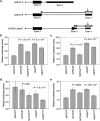Evidence for a role of LPGAT1 in influencing BMI and percent body fat in Native Americans
- PMID: 23505186
- PMCID: PMC3666094
- DOI: 10.1002/oby.20243
Evidence for a role of LPGAT1 in influencing BMI and percent body fat in Native Americans
Abstract
Objective: A genome-wide association study (GWAS) was recently completed in 1120 Pima Indians to identify loci that influence BMI. Among the top 100 signals were three variants that mapped within the lysophosphatidylglycerol acyltransferase 1 (LPGAT1) gene. LPGAT1 belongs to a large family of acyltransferases, which are involved in a variety of biological processes including pathways that regulate energy homeostasis and body weight. Therefore LPGAT1 was analyzed as a candidate gene for obesity in Pima Indians.
Design and methods: Variants (n = 26) located within and adjacent to LPGAT1 including a novel 27bp deletion in the 5'-untranslated region identified by sequencing were genotyped in a population-based sample of 3,391 full-heritage Pima Indians living in the Gila River Indian Community. Replication of selected variants was assessed in a second sample of 3,327 mixed-heritage Native Americans from the same community.
Results: Variants with nominal associations with BMI in each of the two independent samples (tagged by rs112662024 and rs12058008) had associations of P = 1-4 × 10(-5) in the combined sample (n = 6718). A haplotype that includes the novel 27bp deletion, which does not occur in Caucasians, showed the strongest association with BMI in the full-heritage Pima Indians. In vitro functional studies provided suggestive evidence that this 27bp deletion may affect transcriptional or posttranscriptional regulation. Analysis of LPGAT1 cDNA from human preadipocytes identified an additional exon whose sequence could potentially serve as a mitochondrial targeting peptide.
Conclusions: LPGAT1 is a novel gene that influences BMI in Native Americans.
Copyright © 2012 The Obesity Society.
Figures





References
-
- Knowler WC, Pettitt DJ, Saad MF, et al. Obesity in the Pima Indians: its magnitude and relationship with diabetes. Am J Clin Nutr. 1991;53:1543S–1551S. - PubMed
-
- Malhotra A, Kobes S, Knowler WC, Baier L, et al. A genome-wide association study of body mass index in American Indians. Obesity. 2011 (doi: 10.1038/oby.2011.178) - DOI - PMC - PubMed
Publication types
MeSH terms
Substances
Grants and funding
LinkOut - more resources
Full Text Sources
Other Literature Sources
Medical
Molecular Biology Databases

